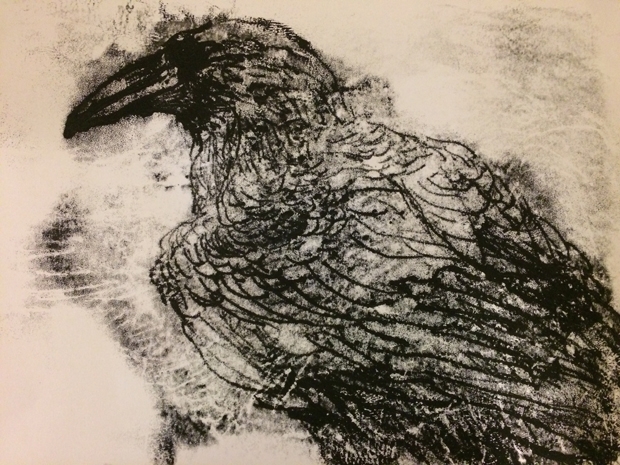On Tower Hill, by the east wall of Beauchamp Tower where Robert Dudley was imprisoned for a year, a raven called Merlin hides behind a yucca plant. I know she’s there because the Ravenmaster told me. He knows she’s there because Merlin (a female) and he are bonded and they keep tabs on each other throughout the day. As he walks across Tower Green, he whistles to her, and in reply, from the shadows, comes a low, metallic, caw.
Ravens pair up for life, for the most part, and Merlin, who dislikes the other ravens, has chosen Chris, the Tower of London’s Yeoman Warder Ravenmaster, as her mate. As he draws near, a beak protrudes slowly from behind the yucca. Patiently, and with respect, Chris strokes the beak and is rewarded with a happy clicking noise, like an old-fashioned telephone dial returning to zero.

The crowds swill around the Beefeaters, eager for stories of torture and beheadings. They learn the legend of the resident ravens: that if they leave the Tower, the kingdom will fall. But it’s a rare tourist who knows what ravens are capable of, or understands what a unique investigation into their psyche the Ravenmaster is presiding over here on Tower Hill.
Until recently, neuroscientists had little time for birds. It was assumed that brain size (relative to body size) was the most significant factor in animal intelligence. What good could any bird brain be? Plus birds have no neo-cortex, which in mammals is vital for intelligence. A seven-year study at Duke University, North Carolina, tested 36 species for their ability to inhibit impulses (a significant part of being clever) and the results were presented, in 2014, as a league table of animal IQ: great apes top, dogs honourably middling, birds at the bottom.

Keith Ashley
But those scientists at Duke had not considered crow-kind. This year, researchers from Lund University in Sweden repeated the Duke experiment with corvids (jackdaws, crows and ravens) and found, to their shock, that these birds were the equal of apes. Ravens, Corvus corax, the smartest of all crows, scored 100 per cent on the Duke test. This was not an anomaly. All around the world scientists are discovering that ravens are alarmingly smart. They will make and use tools to get food; they can grasp abstract concepts and use imagination. Ravens will not only stash food in hidey holes to eat later, but, if they think another bird is watching, they’ll fake-hide their food to fox the competition. This isn’t pre-programmed behaviour — this is considered strategy.
What’s Merlin thinking there, tucked behind the yucca? How does she perceive the world? What goes on in the mind of a raven? Neuroscientists worldwide are puzzling away, testing tame birds with tubes, hooks and bits of string. But here on Tower Hill might lie the best chance of an answer. The Ravenmaster’s birds are wild, but contained; they’re under constant observation and he understands them almost from the inside out. In his book Mind of the Raven, the biologist Bernd Heinrich writes about those, like Merlin, who choose human mates. ‘Observing the birds who had bonded with humans, with an intimacy they normally reserve for other ravens, gave me a different perspective,’ he says. ‘Perhaps one could not hope to appreciate the mind of a raven, any more than one could claim to know the sociobiology of a remote tribe, without first living with, if not marrying into, it.’
Chris and I stand in the lee of the White Tower watching Grip and Harris, the youngest member of the tribe he has married into. They’re playing, says Chris, and quite clearly they are: bouncing on their toes, flapping into the gusts blowing off the Thames, like boys holding their anoraks open so as to test the wind. I tell Chris about a popular YouTube clip of a crow in Russia using a jamjar lid to sledge on a rooftop. Up it treks, lid in beak, to the top, then down it slides on the lid, time after time. Chris’s youngsters behave just the same way, he says. Come a snowfall they’ll find a slope, lie down, fold their wings and roll down, just for the fun of it. Heinrich writes of ravens playing in a friendly way with wolf cubs, tweaking their tails and letting the young animals give chase. When she’s bored, Merlin plays with the tourists. She’ll act dead, says Chris, lying on her back, feet in the air, until they scream and panic and run for help.

Keith Ashley
Heinrich wonders, in his book, whether ravens ever call to crows. Chris knows they do. Merlin will mimic a crow’s call in order to entice them down to play. She and the rest of the Tower Hill gang will chase seagulls away from food dropped by visitors, but they’ll call to their cousin crows to come and sharethe feast.
Perhaps it’s a mark of the cleverness of a species as a whole that its members vary in IQ. He’s just daft, says Chris, indicating a handsome bird called Rocky. Who’s the cleverest bird? Chris’s face softens. I should have guessed: Merlin. She shows the most emotional range, too. Before she bonded with Chris, Merlin’s partner in crime was another female called Hugin, named for one of the Norse god Odin’s two raven familiars: Hugin and Munin, thought and memory. After Hugin died suddenly, Merlin refused to leave her corpse’s side. She stood by her, touching her beak to Hugin’s closed eye. Then she spent three days on the Tower’s north wall, silent and still. Whales, elephants, dolphins and apes have all been known to mourn their dead. Now ravens, too.
Do we have a different moral duty to a species when we discover it’s far cleverer than we thought? Should we protect crows, not shoot them as vermin, if, like ravens, they can grieve? In researching animal intelligence we’ve privileged our primate cousins, and overlooked the birds perched at the very top of another evolutionary tree.







Comments